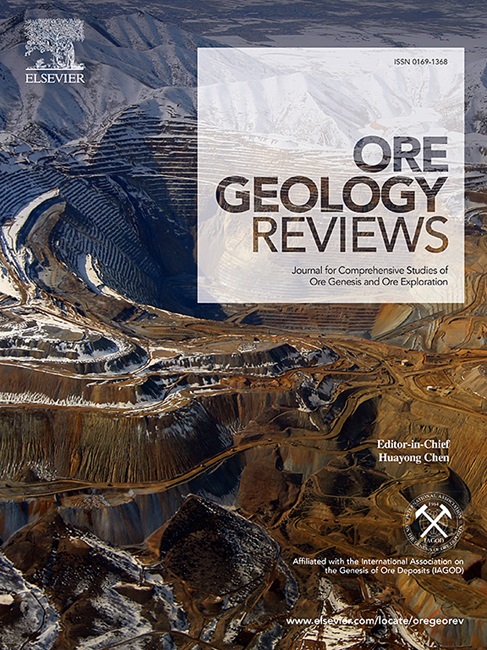Ore genesis of the Nanban gold deposit, West Qinling Orogen: Insights from monazite geochronology and geochemistry of sulfides
IF 3.2
2区 地球科学
Q1 GEOLOGY
引用次数: 0
Abstract
The Nanban quartz vein-hosted gold deposit is located in the West Qinling Orogenic Belt, and the NS-trending faults control gold mineralization. This study integrates deposit geology, hydrothermal monazite U-Pb dating, trace element composition of sulfides, and sulfur isotope characteristics of the Nanban gold deposit, in comparison with the nearby Ludousou reduced intrusion-related gold deposit, to establish the genetic model of the deposit. Hydrothermal monazite U-Pb dating indicates that gold mineralization occurred at 229.8 ± 2.5 Ma. The study has identified two generations of pyrite (Py1 and Py2) and two generations of arsenopyrite (Apy1 and Apy2). The early Py1 and Apy1 samples exhibit compositional homogeneity, with minimal fractures and mineral inclusions. In contrast, Py2 and Apy2 exhibit a greater abundance of mineral inclusions and are extensively fractured, with quartz, galena, and sphalerite filling the fractures. Geochemical analyses show that Py1 and Apy1 have higher concentrations of Co and Ni, while Py2 and Apy2 are enriched in Au, As, Cu, Ag, and Pb. The Ag/Co ratio of Py1 is less than 0.1, while the Ag/Co ratio of Py2 is generally greater than 0.1. All these characteristics indicate that the Py1 and Apy1 might have formed under mild boiling conditions, and Py2 and Apy2 may have occurred under highly variable physicochemical conditions, such as violent fluid boiling. Fluid boiling likely destabilized gold-sulfur complexes, leading to gold precipitation. The sulfur isotope data of the pyrite range from +2.17 ‰ to +6.54 ‰, indicating a deviation from the values observed in nearby magmatic-hydrothermal deposits but demonstrating a similarity to those of authigenic pyrite within the underlying Cambrian black shale. The ore-forming fluids are inferred to originate from metamorphic devolatilization of underlying strata during the Late Triassic syn-collisional event. Differences in mineralization age, ore-forming material sources, and geochemical characteristics between the Nanban and nearby Ludousou gold deposits further support a non-magmatic-hydrothermal origin. The results support the classification of the Nanban gold as orogenic gold deposit. This study further demonstrates that vein-type gold deposits hosted in granitoids do not necessarily have a genetic relationship with the granitoids. Through the integration of geochronological research with sulfur isotope analysis, a more precise determination can be achieved.

西秦岭造山带南板金矿床矿床成因:来自独独居岩年代学和硫化物地球化学的启示
南坂石英脉型金矿床位于西秦岭造山带,南坂石英脉型金矿床受ns向断裂控制。综合矿床地质特征、热液独居石U-Pb测年、硫化物微量元素组成及硫同位素特征,并与邻近的芦豆沟缩缩侵入体相关金矿进行对比,建立矿床成因模式。热液独居石U-Pb测年表明金成矿发生在229.8±2.5 Ma。研究鉴定出两代黄铁矿(Py1和Py2)和两代毒砂(Apy1和Apy2)。早期Py1和Apy1样品成分均匀,裂缝和矿物包裹体极少。Py2和Apy2则表现出更丰富的矿物包裹体,裂缝广泛,石英、方铅矿和闪锌矿充填裂缝。地球化学分析表明,Py1和Apy1富集Co和Ni, Py2和Apy2富集Au、As、Cu、Ag和Pb。Py1的Ag/Co比小于0.1,而Py2的Ag/Co比一般大于0.1。这些特征表明Py1和Apy1可能是在温和的沸腾条件下形成的,而Py2和Apy2可能是在剧烈的流体沸腾等高度变化的物理化学条件下形成的。流体沸腾可能会破坏金-硫络合物的稳定,导致金沉淀。黄铁矿的硫同位素值在+2.17‰~ +6.54‰之间,与附近岩浆热液矿床的硫同位素值存在偏差,但与下伏寒武系黑色页岩中自生黄铁矿的硫同位素值相似。成矿流体来源于晚三叠世同期碰撞事件下伏地层的变质脱挥发作用。南板金矿床成矿年龄、成矿物质来源及地球化学特征的差异进一步支持了其非岩浆热液成因。研究结果支持南坂金矿为造山带金矿床的分类。本研究进一步表明,花岗岩体中的脉状金矿床不一定与花岗岩体有成因关系。通过将地质年代学研究与硫同位素分析相结合,可以实现更精确的测定。
本文章由计算机程序翻译,如有差异,请以英文原文为准。
求助全文
约1分钟内获得全文
求助全文
来源期刊

Ore Geology Reviews
地学-地质学
CiteScore
6.50
自引率
27.30%
发文量
546
审稿时长
22.9 weeks
期刊介绍:
Ore Geology Reviews aims to familiarize all earth scientists with recent advances in a number of interconnected disciplines related to the study of, and search for, ore deposits. The reviews range from brief to longer contributions, but the journal preferentially publishes manuscripts that fill the niche between the commonly shorter journal articles and the comprehensive book coverages, and thus has a special appeal to many authors and readers.
 求助内容:
求助内容: 应助结果提醒方式:
应助结果提醒方式:


